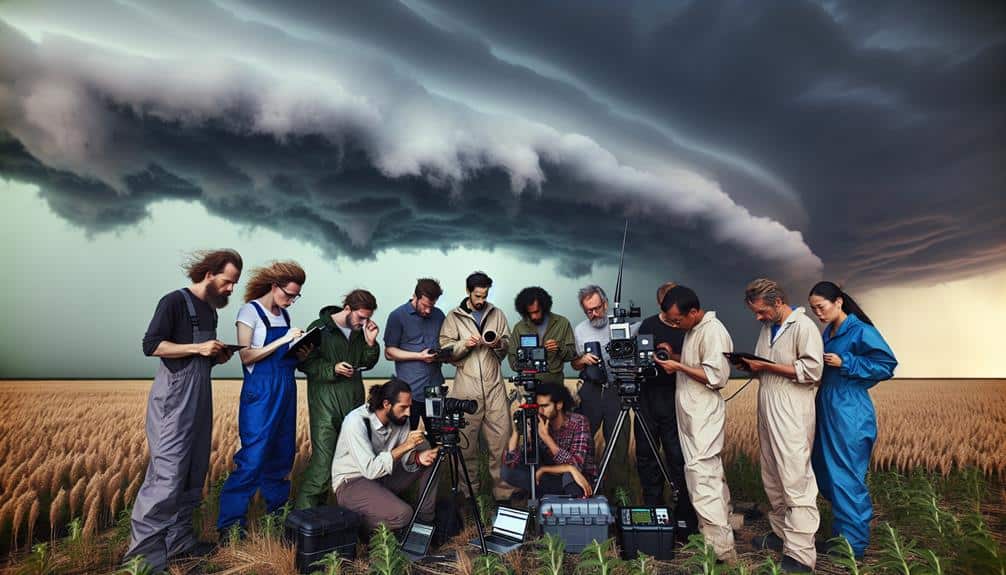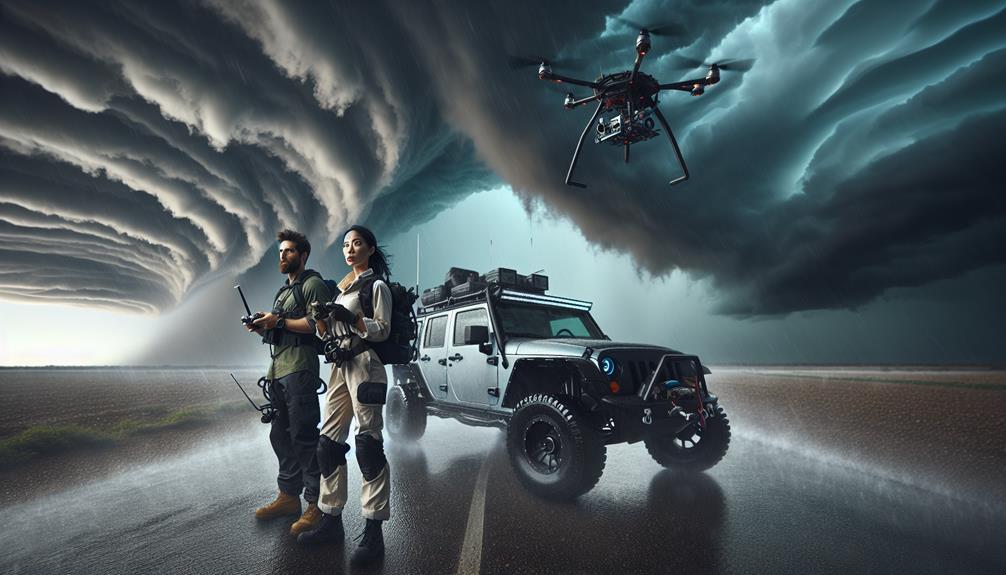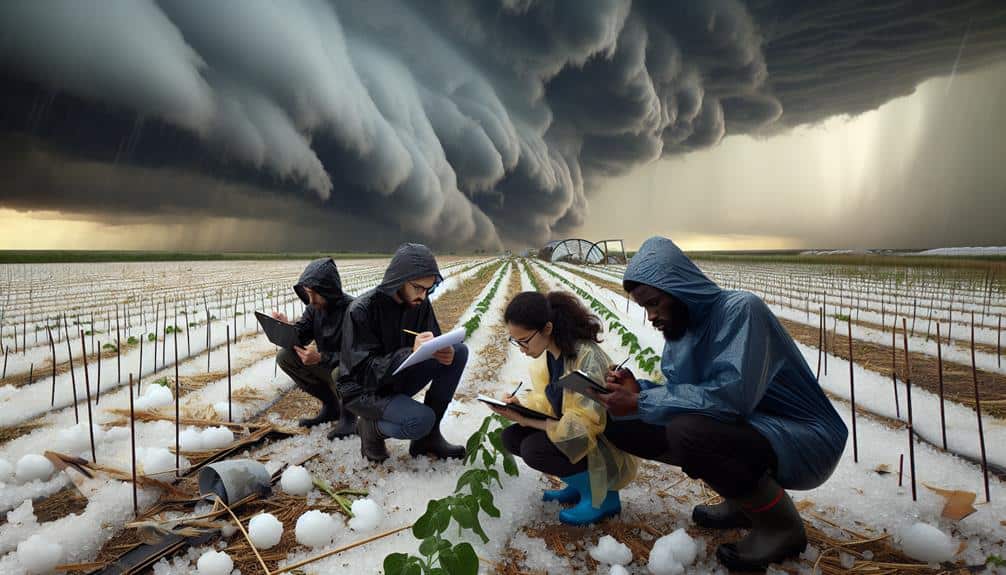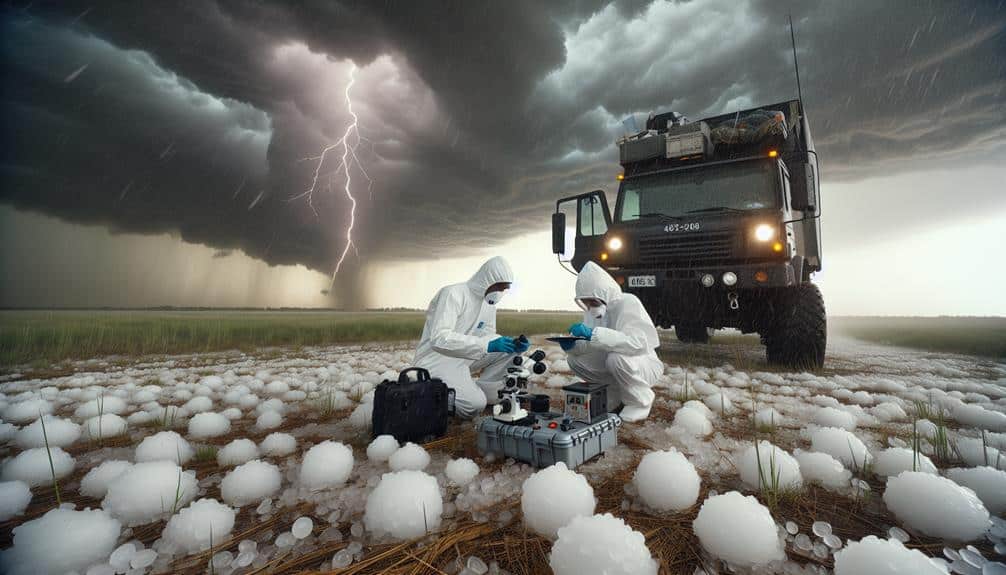We're motivated by a blend of scientific curiosity and sheer adrenaline when pursuing hailstorms. We utilize advanced radar systems, high-resolution cameras, and meteorological software to study extreme weather phenomena. Our goals include validating theories, refining predictive models, and contributing to the understanding of storm dynamics. The thrill of maneuvering through unpredictable conditions and gathering unique data is unparalleled. Additionally, with sophisticated equipment and rigorous data analysis, we enhance weather prediction and disaster preparedness. For those interested in the intricate balance of science and adventure, hailstorm chasing offers a unique pursuit.
Key Points
- Driven by a desire to understand severe weather phenomena and contribute to scientific knowledge.
- Experience the adrenaline rush and excitement of chasing unpredictable and extreme weather.
- Validate or refute existing meteorological theories and improve predictive models.
- Collect unique data using advanced technology to enhance weather prediction accuracy.
Scientific Curiosity
Frequently, hailstorm chasers are driven by a deep scientific curiosity to understand the atmospheric conditions that lead to severe weather phenomena. As a community, we engage in field research to gather empirical data directly from the source. This isn't just about the thrill; it's about uncovering the mechanisms behind natural phenomena like hailstorms.
By immersing ourselves in the heart of these events, we aim to decode the precise factors that contribute to their formation and intensity.
We use advanced meteorological instruments to measure variables such as temperature, humidity, wind speed, and barometric pressure. These parameters help us construct detailed models of storm systems. Our field research allows us to validate or refute existing theories and improve predictive models.
Each hailstorm provides a unique set of data, adding to our collective understanding and enabling more accurate forecasts.
Data Collection
In our data collection efforts, we rely on specialized equipment such as radar systems and hail pads to gather precise meteorological data.
We analyze this data to understand hailstorm patterns and improve predictive models.
Essential Equipment Needs
Hailstorm chasers must equip themselves with high-res cameras, anemometers, and GPS devices to collect accurate and thorough data. High-res cameras allow us to capture minute details of hailstones and storm formations, aiding in post-event analysis.
Anemometers measure wind speeds, providing crucial information about storm intensity. GPS devices ensure precise location tracking, essential for mapping storm paths and correlating data.
Safety precautions are paramount. Our vehicles are often outfitted with advanced technology, including reinforced structures and roll cages, to withstand severe weather conditions. Real-time tracking systems are essential; they enable us to monitor storm movements accurately.
By integrating GPS data with meteorological software, we can predict storm trajectories and make informed decisions. Effective communication strategies are also vital. We use radios and satellite phones to maintain constant contact with fellow chasers and meteorologists.
This facilitates swift information exchange and enhances our safety. Each piece of equipment we carry serves a specific purpose, allowing us to gather comprehensive data while minimizing risks.
Meteorological Data Analysis
We meticulously gather meteorological data, focusing on variables such as temperature, humidity, wind speed, and atmospheric pressure to analyze and predict hailstorm behavior. By collecting this data, we enhance our storm tracking capabilities, allowing us to identify specific weather patterns that lead to hail events. Leveraging sophisticated instruments like Doppler radar and satellite imagery, we engage in pattern recognition to discern trends and anomalies in atmospheric conditions.
Our analytical approach makes certain that we account for the influence of climate change on storm dynamics. As global temperatures rise, the frequency and intensity of hailstorms have shown noticeable shifts. This necessitates a continual update of our forecasting models to maintain forecasting accuracy. By integrating real-time data with historical weather patterns, we refine our predictions and improve the timeliness of our warnings.
Gathering accurate meteorological data isn't just about science—it's about empowering communities to take proactive measures. Our work in data collection and analysis directly contributes to the broader understanding of weather phenomena, enabling individuals to make informed decisions and exercise their freedom in the face of natural hazards. This analytical rigor propels both our passion and commitment to advancing meteorology.
Weather Prediction

Accurate weather prediction relies heavily on real-time data collected by hailstorm chasers. Our commitment to storm tracking directly impacts forecasting accuracy, which is more essential than ever in the face of climate change. By gathering data on hailstorm patterns, we provide necessary insights that enhance meteorological models. This information aids in crafting more precise forecasts, crucial for both daily life and long-term planning.
Hailstorm chasers play a pivotal role in disaster preparedness. When we intercept a storm, we capture high-resolution data on its intensity, trajectory, and potential for damage. This data is immediately relayed to meteorological centers, empowering them to issue timely warnings. Communities can then take necessary precautions, reducing the risk to life and property.
Moreover, our presence in the field serves as a mobile observatory, filling gaps that stationary weather stations might miss. This real-time monitoring is essential for short-term forecasting, especially in volatile weather conditions. As a result, our efforts ensure that weather predictions aren't just statistical guesses but grounded in empirical evidence.
Thrill Seeking
Many hailstorm chasers are driven by the adrenaline rush that comes from confronting nature's raw power. For us, it's not just about the data or the forecast; it's about the visceral excitement of being in the midst of extreme weather.
This thrill-seeking behavior can be broken down into several key motivators:
- Adrenaline Rush: The intense, almost addictive surge of adrenaline experienced during a hailstorm chase is unparalleled. The risk-taking aspect of positioning ourselves close to extreme weather conditions provides a unique and exhilarating experience that few other activities can match.
- Risk Taking: There's an inherent appeal in pushing boundaries and testing our limits against nature's fiercest elements. The calculated risks we take aren't just for the thrill but also to challenge our own capabilities and resilience.
- Excitement of Discovery: Each storm is different, presenting new challenges and opportunities for discovery. The variability and unpredictability of extreme weather keep us engaged and excited, always anticipating the next chase.
Community Contribution

Hailstorm chasers greatly contribute to the community by providing real-time data and insights that enhance public safety and scientific understanding. Our efforts in monitoring and reporting hailstorms allow meteorologists to issue timely warnings, reducing the risk of injuries and property damage. This data-driven approach is essential in refining predictive models, leading to more accurate forecasts.
We also engage in disaster relief efforts. After severe hailstorms, our firsthand assessments help emergency services prioritize their responses, ensuring that aid reaches the most affected areas swiftly. By participating in community engagement initiatives, we raise awareness about hailstorm preparedness and resilience.
Moreover, we actively organize and participate in fundraising events and volunteer opportunities. These activities not only support disaster relief but also fund research projects that aim to improve hailstorm prediction and mitigation strategies. Our involvement in these events fosters a sense of community and shared purpose, empowering individuals to take proactive steps in safeguarding their homes and businesses.
In essence, our role goes beyond chasing storms; we're integral to a network that prioritizes public safety and scientific advancement. Through our collective efforts, we contribute to a community that values freedom and resilience against natural disasters.
Personal Challenge
Chasing hailstorms presents a unique set of personal challenges that test our physical stamina, mental sharpness, and decision-making skills under pressure. The need for mental resilience and physical endurance is essential in these high-stress environments. Not only do we've to stay alert and focused, but we also need the stamina to endure long hours and unpredictable conditions.
To better understand the personal challenges we face, let's break it down into three key components:
- Physical Stamina: Our bodies must endure extended periods of intense activity. This includes driving for hours, often through severe weather conditions, and being ready to spring into action at a moment's notice.
- Mental Resilience: We need to stay mentally strong, dealing with the stress of navigating perilous situations, making quick decisions, and processing vast amounts of real-time data.
- Decision-Making Under Pressure: Rapid analysis and risk assessment are vital. We must evaluate storm patterns, predict movements, and determine safe yet effective routes, often with limited time.
These elements combine to create a demanding yet exhilarating challenge that fuels our passion. By embracing these personal challenges, we not only grow stronger but also reaffirm our commitment to the pursuit of freedom and adventure.
Technological Innovation

While overcoming personal challenges sharpens our skills, technological innovation equips us with advanced tools that enhance our storm-chasing capabilities to a great extent.
Remote sensing and radar technology have revolutionized how we predict and track hailstorms, giving us unprecedented accuracy and lead time. Remote sensing allows us to gather data from a distance, using satellites and ground-based sensors to monitor atmospheric conditions. This real-time data helps us identify potential hailstorm formations before they develop fully. We can analyze variables like temperature, humidity, and wind patterns, which are essential in predicting storm behavior.
Radar technology, particularly Doppler radar, provides detailed information on storm intensity and movement. By emitting radio waves that bounce off precipitation particles, radar systems generate a thorough view of storm structure. This allows us to pinpoint areas of heavy rainfall and potential hail, enabling us to make informed decisions on when and where to chase.
Both technologies offer a sense of freedom, as we're no longer constrained by the unpredictability of nature. With these tools, we can chase storms more safely and efficiently, maximizing our ability to study these natural phenomena while minimizing risks.
Frequently Asked Questions
How Do Hailstorm Chasers Stay Safe During Extreme Weather Conditions?
We understand a stitch in time saves nine, so we follow strict safety precautions and emergency protocols. Our equipment maintenance and communication strategies guarantee we're always prepared, minimizing risks and maximizing our freedom to chase hailstorms safely.
What Kind of Training Do Hailstorm Chasers Undergo?
We undergo rigorous training that combines meteorology knowledge, field experience, and safety protocols. Our curriculum includes emergency response drills and advanced weather analysis, ensuring we're prepared to navigate and document extreme weather conditions safely and effectively.
Are Hailstorm Chasers Usually Employed or Volunteers?
Chaser demographics are more diverse than a rainbow, with both employed and volunteer storm enthusiasts. Employment opportunities and incentives vary, often driven by motivation to study weather phenomena and the thrill of the chase.
How Do Chasers Fund Their Expeditions?
We fund our expeditions through diverse funding sources, including grants and sponsorships. Personal sacrifices are common, as team dynamics often require pooling resources. Equipment costs are significant, but strategic planning guarantees we manage finances effectively.
What Personal Gear Do Hailstorm Chasers Typically Carry?
'Better safe than sorry: We always carry emergency supplies, protective gear like helmets and reinforced clothing, GPS devices, and first aid kits. These essentials guarantee we stay safe while experiencing the freedom of chasing storms.'


